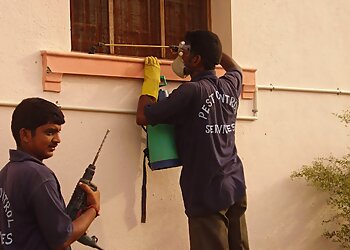Chicago Crawler Extermination Services: Safe and Reliable Removal
Chicago Crawler Extermination Services: Safe and Reliable Removal
Blog Article
A Comprehensive Overview to the Various Kinds Of Bug Control Methods
With the myriad of insect control methods readily available, it can be frustrating to locate the most reliable remedy for a certain pest trouble. In this detailed guide, we will check out these various types of parasite control approaches, using insights into their applications and advantages. By the end, you will have a more clear understanding of which method may be the best fit for your parasite control needs.
Chemical Pest Control Techniques

One usual type of chemical pest control is insecticides. Pesticides target particular insects, such as insects, termites, or ants, and can be utilized both inside your home and outdoors.
Another sort of chemical pest control is rodenticides. These are chemical compounds developed to regulate populaces of rats, such as rats and computer mice. Rodenticides are usually used in bait form, which attracts the rats and after that kills them after ingestion. They are frequently used in farming setups, as well as in residential and commercial structures (Customized pest control solutions Chicago).
Weed awesomes, also called herbicides, are another kind of chemical bug control technique. Herbicides are designed to uniquely kill undesirable plants, recognized as weeds, without triggering harm to desirable plants. They are commonly utilized in agriculture, landscaping, and gardening to manage the growth of unwanted plants.
While chemical bug control techniques can be very reliable in getting rid of pests, it is essential to utilize them judiciously and follow safety and security guidelines. Overuse or abuse of chemical pesticides can have adverse influences on human health and wellness and the environment. It is essential to utilize these methods sensibly and consider different bug control strategies whenever feasible.
Biological Parasite Control Methods
Biological bug control techniques entail the usage of living microorganisms or all-natural compounds to handle and control pest populaces. Unlike chemical methods, which often rely upon synthetic pesticides, biological control techniques make use of the natural adversaries of parasites to control their populations. This method is thought about more eco friendly and sustainable, as it lowers the use of dangerous chemicals and reduces the risk of chemical resistance.
One widely made use of organic bug control approach is the introduction of natural killers or parasites. For instance, ladybugs are presented to regulate aphids, while certain wasp varieties are launched to target caterpillars. These predators and parasites feed on parasites, minimizing their numbers and protecting against invasions.
Another organic control method is the usage of microorganisms. Specific bacteria, viruses, and fungis can be utilized to contaminate and eliminate certain insects. For instance, the microorganism Bacillus thuringiensis is generally made use of to manage caterpillars, as it produces toxins that are lethal to these parasites.
Organic see post control methods can additionally include the use of scents or natural compounds that interfere with the mating patterns of pests. By hindering their reproduction, these methods assist to decrease pest populations in time.
While organic bug control techniques are generally effective, they may require longer durations to attain desired outcomes contrasted to chemical approaches. Furthermore, cautious factor to consider has to be given to the selection and release of all-natural enemies to stop unexpected harm to valuable microorganisms or ecosystems.
Physical Insect Control Techniques
To effectively handle and regulate pest populations, alternative bug control approaches referred to as physical insect control approaches are employed. These approaches entail using physical barriers, traps, or tools to avoid parasites from accessing or harming property. One usual physical parasite control method is the usage of screens or internet to keep pests out of structures or yards. These displays are usually made from great mesh material that allows for air flow while avoiding pests from getting in. Another physical parasite control method is the installation of fencings or wall surfaces to keep larger pests, such as deer or bunnies, out of yards or agricultural fields. These barriers literally obstruct the insects' access to the area, lowering the potential for damages. Furthermore, traps and gadgets can be made use of to record or ward off pests. As an example, sticky catches can be positioned in locations where insects are a problem, and the insects become adhered to the adhesive surface area. Ultrasonic tools can also be utilized to emit high-frequency audios that are undesirable to bugs, causing them to leave the location. Physical bug control techniques are an ecologically pleasant alternative to chemical pesticides, as they do not rely upon making use of hazardous chemicals.
Natural Bug Control Approaches
All-natural parasite control approaches provide a lasting and environmentally friendly technique to handling and eliminating bugs. One of the most usual natural bug control methods is biological control. By adopting these natural parasite control techniques, people and areas can successfully handle insects while lessening the adverse influences on the environment and human health.
Integrated Insect Monitoring (IPM)
Integrated Parasite Monitoring (IPM) is an extensive and methodical approach to pest great post to read control that incorporates different approaches and techniques to effectively manage pests while decreasing the use site web of chemical pesticides. IPM aims to preserve parasite populaces below the economic injury level by using a combination of social, biological, and chemical control techniques.
Cultural control techniques include customizing the setting to make it much less beneficial for parasites. This can consist of practices such as crop rotation, appropriate cleanliness, and using resistant plant varieties. By producing negative problems for parasites, cultural control methods can substantially lower pest populaces.

Chemical control methods are used as a last hope in IPM. They include the targeted and judicious use of pesticides to manage insect populations. Unlike traditional bug control methods, IPM aims to lessen using chemical pesticides by employing different techniques.
Integrated Bug Administration (IPM) is an aggressive strategy that concentrates on long-lasting insect administration as opposed to counting only on reactive steps. By integrating numerous control techniques, IPM provides a much more lasting and eco-friendly strategy to pest control.
Final Thought
It discussed chemical, organic, physical, and natural pest control approaches, as well as the integrated bug administration strategy. By understanding these numerous techniques, individuals can make informed choices on which pest control approach is most appropriate for their details demands and choices.
Report this page